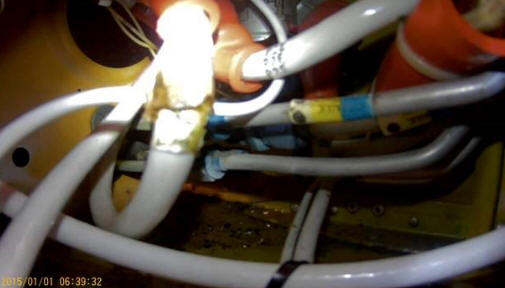|
|
|
Piper
PA-31T Wiring Issue Prompts NTSB Urgent Safety
Recommendation |
| |
January 13, 2017
- The National Transportation Safety Board
issued an urgent safety recommendation to the
FAA on Monday concerning unsafe wiring on Piper
PA-31T-series aircraft that may lead to arcing
and cause fires.
The urgent safety recommendation is based upon
preliminary findings in the ongoing
investigation of the July 29, 2016, in-flight
breakup of a Piper PA-31T medical transport
flight in California.
On July 29, 2016, a twin-engine,
turbine-powered, Piper PA-31T Cheyenne II
airplane, N661TC, reported smoke in the cockpit
and subsequently sustained an in-flight breakup
and collision with tree-covered terrain near
Arcata/Eureka Airport, McKinleyville,
California.
|
|
 |
| In this photo taken in an
exemplar Piper PA-31T, white electrical lines
are in close proximity to metal hydraulic lines.
The NTSB believes this wiring may chafe and then
arc, causing a fire and subsequent damage to
hydraulic lines. NTSB photo by Mike Bauer |
The Piper
Cheyenne was operated by Cal-Ore Life Flight as
an instrument flight rules (IFR) air transport
medical flight under Part 135. The airline
transport pilot, two medical personnel, and one
patient were killed and the aircraft sustained
substantial damage. Dark night, instrument
meteorological conditions prevailed. The flight
departed Crescent City, California, just after
midnight, destined for Oakland International
Airport, Oakland, California.
Investigators found evidence of thermal damage
near the airplane’s main electrical bus circuit
breaker panel. This enclosed space also includes
hydraulic lines that run directly below the
panel. Further examination of the wiring in this
area showed evidence of electrical arcing, and
sections of the adjacent hydraulic lines were
consumed by in-flight fire. Evidence thus far
indicates that the in-flight fire occurred in
the area where these electrical wires and
adjacent hydraulic lines may have been in
contact.
Current maintenance procedures, which only
specify a general visual inspection, do not
provide adequate guidance for inspection in the
area of the floor-mounted circuit breaker panel
because of its location and the confined space
in that area. Thus, contact between electrical
wires and hydraulic fluid lines can persist
undetected. |
|
|
